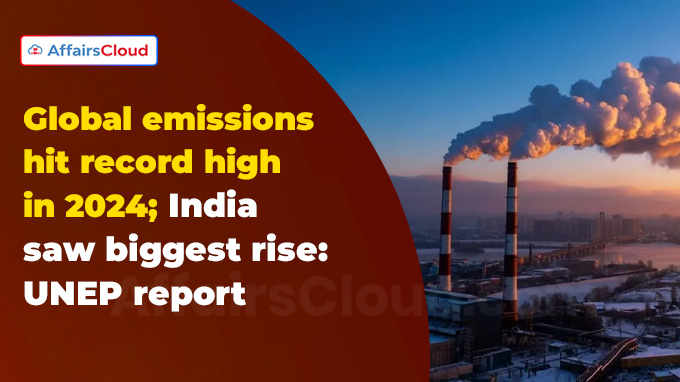In November 2025, the United Nations Environment Programme (UNEP) released the 16th edition of a report titled ‘The Emissions Gap Report(EGR) 2025: Off Target-Continued Collective Inaction Puts Global Temperature Goal at Risk’. As per the report, the global emissions of Greenhouse Gases (GHGs) reached a record high of 57.7 Gigatonnes of Carbon Dioxide equivalent (GtCO2e) in 2024, marking an increase of 2.3% compared to 2023 emissions.
- This global increase in GHG emissions in more than 4 times higher than the annual average growth rate in 2010s (0.6% per year), and comparable to the emissions growth in 2000s (on average 2.2% per year).
- The report also showed that India (+0.165GtCO2e) recorded the largest year-on-year (Y-o-Y) increase in emissions, followed by China, Russia , Indonesia and the United States of America (USA).
Exam Hints:
- What? Release of UNEP’s EGR 2025
- Title: “Off Target-Continued Collective Inaction Puts Global Temperature Goal at Risk”
- Edition: 16th
- Global GHG Emissions in 2024: 57.7 GtCO2e (+2.3% Y-o-Y)
- Top Countries by Absolute Increase: India (+0.165 GtCO₂e), China, Russia, Indonesia, USA
- Top 6 Largest Global Emitters: China, USA, India, EU, Russia, Indonesia
- Key Contributors: Fossil fuels and LULUCF
- Emissions Reduction Targets:
- 2°C goal: Reduce annual emissions by 35% by 2035
- 1.5°C goal: Reduce annual emissions by 55% by 2035
About Emissions Gap Report(EGR):
Annual Publication: The EGR is published every year by the UNEP to track global efforts in combating climate change.
- It monitors progress toward limiting global warming to well below 2 degree Celsius(°C) and striving to achieve the 1.5°C target outlined in the Paris Agreement.
Collaborative Effort: The EGR is co-produced by UNEP, the UNEP Copenhagen Climate Centre (UNEP-CCC), and other partners, ensuring a comprehensive and authoritative assessment.
Scope of Analysis:The report focuses on emissions from fossil fuels, including CO₂, CH₄ (methane), N₂O (nitrous oxide), and F-gases (fluorinated gases), while excluding emissions from land-use change and forest cover due to data uncertainties.
Key Findings of EGR 2025:
Key Drivers: The global increase in GHG emissions in 2024 was mainly driven by: global net Land Use, Land-Use Change and Forestry (LULUCF) CO2 (+21%); followed by fossil CO2 (+36%).
Temperature Projection: The report highlighted that even if countries fully implement their updated Nationally Determined Contributions (NDCs), average global temperatures are expected to increase by 2.3°C to 2.5°C above pre-industrial levels by the end of the century.
- This projection marks a modest increase compared to last year’s 2.6°C to 2.8°C.
NDC Submissions: As of September 2025, only 60 countries (63% of global emissions) had submitted or announced new NDCs for 2035, while just 13 countries representing less than 1% of global emissions had updated their 2030 NDCs.
Global Emitters: As per the report, China, the USA, India, the European Union (EU), Russia and Indonesia continue to be the largest global emitters, of these, the EU was the only one to decrease emissions in 2024.
- The report further showed countries which recorded the fastest growth rate in emissions: Indonesia (4.6%); India (3.6%) and China (0.5%).
Highest Per Capita Emissions: As per the report, per capita GHG emissions in countries like: the USA, Russia, China and the EU continue to be higher than the global average of 6.4 tonnes CO2e.
- While, per capita GHG emissions in India and Indonesia remain below the global average.
G20 Countries Highest Emitter: Apart from emissions from land use, emissions from Group-20 (G20) countries (excluding the African Union,AU) accounted 77% of global emissions over 2023-24.
- Although, seven G20 countries have submitted new NDCs, collectively, G20 countries are not on track to achieve their NDC targets for 2030.
Warning: The report cautioned that ongoing delays in meeting Paris Agreement targets make it highly likely that global temperatures will surpass 1.5°C within the next decade.
Emissions Reduction Targets: The report recommended that in order to align with 2°C and 1.5°C targets, countries are required to reduce annual emissions by 35% and 55% by 2035, compared with 2019 levels, respectively.
Recent Related News:
In October 2025, the United Nation Environment Programme (UNEP) released a report titled “High-risk forests, high-value returns: A co-benefit assessments for decision-makers”, in which it highlighted that around 391 million (mn) hectares (ha) of tropical forests are at high risk of deforestation.
- These are areas with high carbon stocks, significant additional ecosystem services, and a high likelihood of deforestation. Together they cover about 391 mn ha of tropical forests, nearly one-fourth of the world’s total 1.6 billion (bn) ha of tropical forest area.




